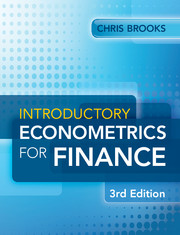Book contents
- Frontmatter
- Contents
- List of figures
- List of tables
- List of boxes
- List of screenshots
- Preface to the third edition
- Acknowledgements
- 1 Introduction
- 2 Mathematical and statistical foundations
- 3 A brief overview of the classical linear regression model
- 4 Further development and analysis of the classical linear regression model
- 5 Classical linear regression model assumptions and diagnostic tests
- 6 Univariate time series modelling and forecasting
- 7 Multivariate models
- 8 Modelling long-run relationships in finance
- 9 Modelling volatility and correlation
- 10 Switching models
- 11 Panel data
- 12 Limited dependent variable models
- 13 Simulation methods
- 14 Conducting empirical research or doing a project or dissertation in finance
- Appendix 1 Sources of data used in this book
- Appendix 2 Tables of statistical distributions
- Glossary
- References
- Index
8 - Modelling long-run relationships in finance
- Frontmatter
- Contents
- List of figures
- List of tables
- List of boxes
- List of screenshots
- Preface to the third edition
- Acknowledgements
- 1 Introduction
- 2 Mathematical and statistical foundations
- 3 A brief overview of the classical linear regression model
- 4 Further development and analysis of the classical linear regression model
- 5 Classical linear regression model assumptions and diagnostic tests
- 6 Univariate time series modelling and forecasting
- 7 Multivariate models
- 8 Modelling long-run relationships in finance
- 9 Modelling volatility and correlation
- 10 Switching models
- 11 Panel data
- 12 Limited dependent variable models
- 13 Simulation methods
- 14 Conducting empirical research or doing a project or dissertation in finance
- Appendix 1 Sources of data used in this book
- Appendix 2 Tables of statistical distributions
- Glossary
- References
- Index
Summary
Learning outcomes
In this chapter, you will learn how to
• Highlight the problems that may occur if non-stationary data are used in their levels form
• Test for unit roots
• Examine whether systems of variables are cointegrated
• Estimate error correction and vector error correction models
• Explain the intuition behind Johansen's test for cointegration
• Describe how to test hypotheses in the Johansen framework
• Construct models for long-run relationships between variables in EViews
Stationarity and unit root testing
8.1.1 Why are tests for non-stationarity necessary?
There are several reasons why the concept of non-stationarity is important and why it is essential that variables that are non-stationary be treated differently from those that are stationary. Two definitions of non-stationarity were presented at the start of chapter 6. For the purpose of the analysis in this chapter, a stationary series can be defined as one with a constant mean, constant variance and constant autocovariances for each given lag. Therefore, the discussion in this chapter relates to the concept of weak stationarity. An examination of whether a series can be viewed as stationary or not is essential for the following reasons:
The stationarity or otherwise of a series can strongly influence its behaviour and properties. To offer one illustration, the word ‘shock’ is usually used to denote a change or an unexpected change in a variable or perhaps simply the value of the error term during a particular time period.[…]
- Type
- Chapter
- Information
- Introductory Econometrics for Finance , pp. 353 - 414Publisher: Cambridge University PressPrint publication year: 2014
- 1
- Cited by



